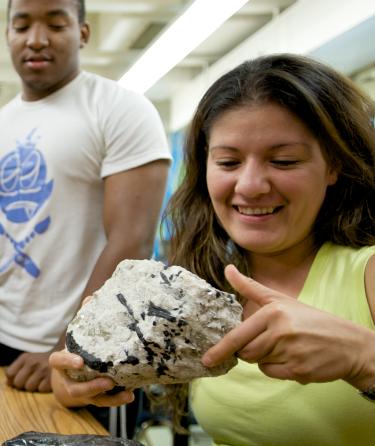Geology
Degrees Offered
Associate in Arts Degree in Geology - Major Code 1914.00
Transfer students should consult the Counseling Office for major preparation and general education requirements for the particular transfer institution of their choice.
Transfer students who want to obtain an Associate degree may do so by completing all WLAC general education requirements plus at least 18 units in the major as required by the transfer institution (a total of 60 units for an Associate Degree).
Associate in Arts Degree (40 units, Plan B)
The Associate Degree program in Geology emphasizes lower-division requirements for this major. Students who wish to obtain an Associate degree in Geology may do so by completing the course requirements listed below PLUS all other WLAC requirements for an Associate degree.
REQUIRED COURSES
- CHEM 101 General Chemistry I (5 units)
- CHEM 102 General Chemistry II (5 units)
- GEOLOGY 1 Physical Geology (3 units)
- GEOLOGY 6 Physical Geology Laboratory (2 units)
- MATH 261 Calculus I (5 units)
- MATH 262 Calculus II (5 units)
- PHYSICS 37 Physics for Engineers and Scientists I (5 units)
- PHYSICS 38 Physics for Engineers and Scientists II (5 units)
- PHYSICS 39 Physics for Engineers and Scientists III (5 units)
NOTE: Always review requirements of the institution to which you plan to transfer.
Physical Geology (Geology 1) is a 3 unit course that surveys the materials and structures of the earth and the agents and processes that modify it. A study of rocks and their mineral composition; the work of rivers, winds, glaciers and oceans as agents of erosion; and volcanoes and earthquakes as forces which change the surface of the earth are covered. The main purpose of the class is to stimulate student interest in the geological aspects of the environment in which they will spend their lives.
NOTE: Geology 1 and Geology 6 taken together fulfill a laboratory science course.
Textbook: Lutgens, F.K. & Tarbuck, E.J. (2012). Essentials of Geology, 11th ed.; PEARSON/Prentice Hall publishers; ISBN 978-0-321-71472-5 (print); ISBN- 978-0-321-74119-6 (eText).
Transfer: UC/CSU
Prerequisite: None
Student Learning Outcomes:
Upon completion of this course the student will be able to:
- Describe the materials that make-up solid Earth and processes that shape its surface features.
- Use physical & chemical data on minerals, fossils, and rocks to classify them, determine their ages, and explain their origins.
Geology 6 is a 2 unit laboratory course that deals with laboratory exercises that aid students in the identification of rock-forming minerals, igneous, metamorphic and sedimentary rocks, and the interpretation of topographic and geologic maps. Note: Geology 1 and Geology 6 taken together fulfill a laboratory science course.
NOTE: Geology 1 and Geology 6 taken together fulfill a laboratory science course.
Textbook: Busch, R.M., ed. (2011). Laboratory Manual in Physical Geology. 9th Edition. American Geological Institute – National Association of Geoscience Teachers. PEARSON/Prentice Hall. ISBN 978-0-321-68957-3.
Transfer: UC/CSU
Prerequisite/Co-requisite: Physical Geology (Geology 1) or concurrent enrollment in Physical Geology 1 (Geology 1).
Student Learning Outcomes:
Upon completion of this course the student will be able to:
- Apply scientific methods to analyze geologic materials and explain dynamic processes of our planet earth.
- Use maps, images, seismograms and other geologic data to quantitatively explain geologic phenomena and processes.

